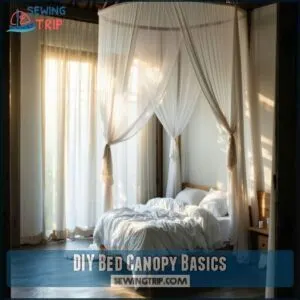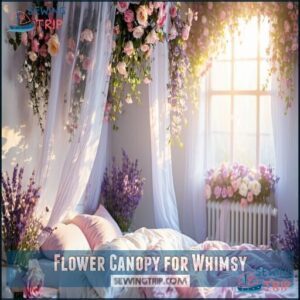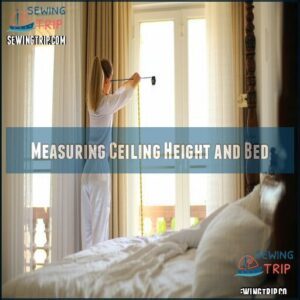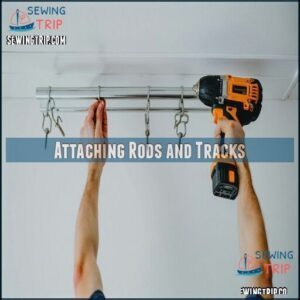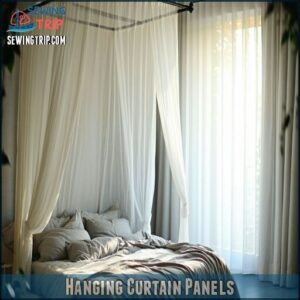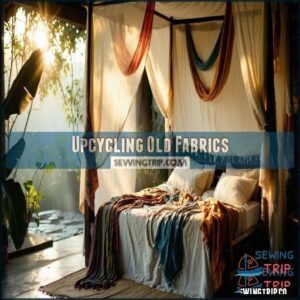This site is supported by our readers. We may earn a commission, at no cost to you, if you purchase through links.
 You’ll love creating your own tutorials—diy bed canopy — it’s like wrapping your bed in a cloud!
You’ll love creating your own tutorials—diy bed canopy — it’s like wrapping your bed in a cloud!
Start with simple materials: ceiling hooks, sheer curtains, and a embroidery hoop or PVC pipes.
Mount your hooks in the ceiling directly above your bed corners, then hang your fabric or attach it to your frame.
You can add fairy lights or artificial vines for that dreamy touch without breaking the bank.
Most canopies come together in under 30 minutes, turning your ordinary bedroom into a personal sanctuary.
The secret to the perfect canopy? It’s all in how you drape the fabric…
Table Of Contents
Key Takeaways
- You can create a DIY bed canopy with simple materials like ceiling hooks, sheer curtains, and embroidery hoops or PVC pipes, transforming your bedroom into a personal sanctuary in under 30 minutes.
- Your bed canopy provides both style and function—it creates a cozy retreat that improves sleep quality, adds visual appeal, offers privacy in shared spaces, and can help regulate temperature.
- You’ll need four essential items for a successful canopy: fairy lights for a magical glow, mosquito netting for princess-inspired designs, artificial ivy for a verdant retreat, and heavy-duty hooks for secure installation.
- You don’t need to drill holes—you can use command hooks, tension rods, or create a freestanding design with a weighted base for a no-damage installation that works in any space.
DIY Bed Canopy Basics
You’ll transform your bedroom into a dreamy retreat with a DIY bed canopy that adds style, privacy, and a touch of magic without breaking the bank.
From sheer fabrics that create an airy feel to heavier materials that block light, you’ll find the perfect canopy option to match your personal style and functional needs.
History of Bed Canopies
Tracing the ancestral roots of bed canopies reveals a rich tapestry of history that still influences today’s DIY designs.
- Ancient origins in the Far and Middle East, appearing in China as early as the 4th century
- Medieval designs introduced to Europe by Crusaders in the 13th century
- Cultural symbols of wealth and nobility in medieval Europe
- Functional history as protection from drafts, insects, and even "evil spirits"
For a luxurious look, consider silk and velvet for your canopy, which can add a touch of medieval Europe flair, emphasizing the cultural symbols of the past.
Benefits of Having a Bed Canopy
While ancient royalty used canopies for warmth, today’s bed canopies offer benefits beyond history.
A bed canopy transforms your bedroom into a personal sanctuary with tangible advantages:
A bed canopy isn’t just decor—it’s your personal retreat from the world, enveloping you in cozy, dreamy comfort.
- Creates a cozy retreat that improves sleep quality
- Adds stunning visual appeal to your bedroom decor
- Provides much-needed privacy in shared spaces
- Regulates temperature for year-round comfort
- Establishes a relaxing oasis that reduces stress
These simple additions make your bedroom both stylish and functional, creating a cozy retreat.
Choosing The Right Fabric
Now that you know the benefits, let’s talk fabric—it’ll make or break your canopy dreams.
Sheer fabrics like voile create an airy, dreamy feel while letting light filter through. Heavyweight textiles offer coziness and better light blocking for those who need darkness to sleep well.
Consider your room’s color scheme when choosing. Texture options matter too—from silky smooth to nubby linen.
For a variety of options, consider different canopy materials. On a budget? Upcycled fabric from old curtains or sheets works beautifully, adding character while saving cash.
Top 4 DIY Canopy Essentials
You’ll need these four must-have items to transform your bedroom into a dreamy retreat without breaking a sweat.
From twinkling fairy lights that create magical shadows to sturdy hooks that won’t let your canopy dreams come crashing down at 3 AM, these essentials make DIY canopy-making as easy as making your bed.
Well, maybe even easier, these essentials are crucial for a successful DIY project, ensuring that your canopy dreams come true.
1. Battery Operated Star Fairy String Lights Warm White

Now that you understand the basics, let’s brighten up your canopy! Battery operated star fairy string lights add that perfect warm glow to transform your sleeping space.
With these twinkling wonders, you can:
- Create a starry night effect by weaving lights through sheer fabric
- Outline your bed frame for a gentle bedtime glow
- Arrange in patterns for personalized light designs
Their 6-8 hour battery lifespan means worry-free illumination. Safety’s no concern with their cool operation, making them perfect for DIY canopy beds.
For a more bohemian look, consider adding macrame and fringe. Place them anywhere—no outlet needed!
2. Mosquito Net Bed Canopy for Girls Princess
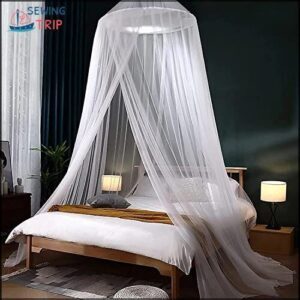
A princess-inspired mosquito net canopy transforms any bed into a dreamy royal retreat while keeping pesky bugs at bay.
This dual-purpose essential combines function with fairytale charm.
| Feature | Benefit | Installation Tip |
|---|---|---|
| Fine mesh netting | Blocks mosquitoes without blocking airflow | Hang from a single hook for a waterfall effect |
| Generous circumference | Creates full 360° coverage | Use ceiling-mounted hook for best draping |
| Decorative crown topper | Adds princess aesthetics | Center precisely above bed’s middle point |
Perfect for creating that safe, magical sanctuary where DIY canopy bed dreams come true without complex installation steps.
3. Artificial Ivy Garland Greenery Fake Vines Hanging Plants
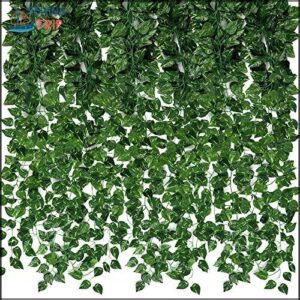
Moving from princess mosquito nets to natural elements, artificial ivy garland transforms your bed canopy into a verdant retreat. These faux vines offer lush greenery textures without the upkeep of real plants.
Drape these lifelike strands around your canopy frame for an instant forest-like feel. "I’ve had my ivy garlands for three years now, and guests still try to water them!" jokes one DIY enthusiast.
The versatility of these vines makes them perfect for any canopy tutorial:
- Wind them through fairy lights for a magical glow
- Layer multiple garland types for depth and dimension
- Clip small flowers into the ivy for seasonal changes
- Combine with sheer fabrics for a dreamy effect
- Intertwine with existing canopy curtains for added texture
Hanging techniques are simple—just weave, clip, or tie the garland where you want that touch of greenery. The garland longevity is impressive too, maintaining its vibrant appearance for years, which is a key aspect of its versatility.
4. Outdoor Christmas Light Clips Heavy Duty Metal Hooks
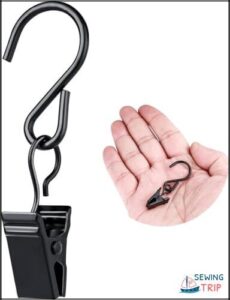
Those heavy-duty metal hooks are truly the unsung heroes of any DIY bed canopy project.
With impressive weight capacity, these outdoor Christmas light clips securely hold fabrics, string lights, or ivy garlands without sagging.
They’re designed for multiple installation surfaces—from ceiling drywall to wooden beams.
Their clip durability makes them perfect for your canopy tutorial needs, as they won’t bend or break under tension.
Plus, their weather resistance means they’ll last for years, even in humid bedrooms.
When following any how-to make canopy guide, don’t underestimate these little workhorses—they’re the secret to a professional-looking DIY bed canopy that stays put.
Canopy Design Ideas
You’ll transform your bedroom into a personal sanctuary with these quick and stunning canopy designs that fit any style or budget.
From whimsical flower arrangements to rustic wooden frames, these ideas let you create magic above your bed in just half an hour.
Camping Tent Bed Canopy
While dreaming of outdoor adventures, you can transform your bedroom into a cozy retreat with a camping tent bed canopy.
Simply combine lightweight tent materials with PVC pipe curtains to create your DIY canopy bed frame.
This design offers excellent ventilation options and bug protection while bringing the magic of indoor camping to your space.
It’s an easy bed canopy project that’ll have you feeling like you’re sleeping under the stars!
Flower Canopy for Whimsy
While your garden dreams flourish indoors, a flower canopy transforms your bedroom into a whimsical retreat.
Choose delicate blooms for your DIY canopy bed, focusing on Floral Selection that complements your color scheme.
Lightweight Hanging Techniques guarantee safety, while strategic Color Coordination enhances your space.
Consider dried flowers for minimal Maintenance Tips and subtle Scent Considerations.
This canopy tutorial creates a magical sanctuary that’s surprisingly easy to craft.
Simple Straight Canopy for Budget
Frequently, the simplest designs make the biggest impact in bedroom decor.
A straight canopy offers budget-friendly elegance without breaking the bank.
- Budget materials like sheer curtain panels cost under $20
- Easy installation requires just ceiling hooks and curtain rods
- Minimalist design creates an instant focal point
- Quick setup takes less than 30 minutes
This style often utilizes simple lines and neutral tones. This affordable elegance transforms your sleeping space into a cozy retreat that looks expensive but isn’t.
Your DIY bed canopy journey starts here!
Dreamy Canopy for Style
A dreamy canopy transforms your bedroom into a stylish sanctuary with minimal effort.
Create ethereal vibes by combining delicate fabric draping with strategic lighting effects.
| Style Element | Materials | DIY Difficulty |
|---|---|---|
| Fabric Draping | Voile/Gauze | Easy |
| Color Palettes | Pastels/Neutrals | Medium |
| Texture Combinations | Lace/Satin | Medium |
For a truly enchanting DIY bed canopy, layer sheer curtains and add string lights for that magical glow you’ll love drifting off under.
Rustic and Modern Canopy Designs
While dreamy styles have their place, rustic and modern canopy designs bring character to your bedroom.
Blend natural elements with sleek lines for a stunning look.
- Woodland Canopy: Incorporate unfinished wood beams with trailing ivy for a forest retreat feel
- Industrial Canopy: Pair metal accents with exposed pipes for an urban loft vibe
- Farmhouse Canopy: Use distressed wood and simple white fabric for that cozy minimalist design
You’ll love how these DIY bed canopy styles transform your space!
DIY Canopy Installation Tips
You’ll transform your bedroom into a dreamy retreat with these easy-to-follow canopy installation tips that won’t leave you tangled in fabric or climbing wobbly ladders.
From measuring your ceiling height to selecting the right hardware, we’ve got all the practical advice you need to hang your canopy safely and beautifully in just minutes.
Measuring Ceiling Height and Bed
After choosing your favorite canopy design, precise measurements become your best friend.
Grab your tape measure and note your room dimensions and ceiling height – these determine fabric length. For example, 8-foot ceilings typically need 7-foot fabric lengths for elegant draping.
Measure your bed width and placement to determine rod length and hardware sizing. This creates visual balance in your DIY bed canopy tutorial.
For ceiling mounted canopies, add 12 inches to bed measurements for proper overhang. Perfect measurements guarantee stunning results and help achieve an elegant draping effect.
Attaching Rods and Tracks
Every successful bed canopy starts with properly attaching your rods and tracks.
Securing rods and tracks isn’t just preparation—it’s the foundation that transforms fabric into fantasy.
You’ll need these five essentials for secure installation:
- Ceiling hook placement in studs for maximum stability
- Curtain rod types that match your decor and weight needs
- Track installation hardware appropriate for your ceiling material
- Secure fastening techniques to prevent sagging
- Canopy frame supports strategically positioned for even weight distribution
Don’t rush this critical step! Consider canopy track options for easier installation.
Taking time with your DIY tutorials now guarantees your ceiling-mounted curtain rods will showcase your canopy without unexpected midnight collapses. This will ensure a secure installation and provide maximum stability, which is essential for a successful bed canopy.
Hanging Curtain Panels
Now that your rods are securely attached, it’s time to hang those curtain panels! With the right technique, your DIY bed canopy will transform from hardware to heavenly in minutes.
| Panel Style | Length | Hanging Method | Rod Placement | Effect |
|---|---|---|---|---|
| Sheer | 63" | Garden hooks | Ceiling | Airy, light |
| Heavyweight | 84" | Larger rod | Wall mounted | Cozy, private |
| Draped | Varied | Hidden rod | Behind primary | Hides seams |
| Gathered | Full | Multiple hooks | Middle support | Stability |
| Flowy | Long | Ceiling mount | Corner posts | Dramatic |
For securing curtain panels, consider using specialized hanging hardware for perfect fabric gathering. Verify hook stability at both ends and middle points to ensure stability and a cozy atmosphere, which will make your DIY project look professional and feel airy and light.
Upcycling Old Fabrics
Now that your curtain panels are ready to hang, let’s talk about fabric sourcing with a twist!
Breathe new life into old fabrics by upcycling bedsheets, vintage scarves, or worn tablecloths for your DIY bed canopy. These materials aren’t just budget-friendly—they tell a story.
Simply wash, cut to size, and prep your chosen fabric. For a minimalist touch, consider sheer fabrics for your canopy.
Old linen curtains can transform into dreamy canopy panels with minimal effort, adding unique character no store-bought option can match.
Safety Precautions and Common Mistakes to Avoid
Now that you’ve sorted out your fabric options, let’s talk safety – because nobody wants their dreamy canopy turning into a nightmare!
Creating your DIY bed canopy safely means avoiding these common pitfalls:
- Distribute Weight Evenly – Balance your canopy frame to prevent tipping. Multiple support points will keep your masterpiece from crashing down mid-dream.
- Secure Mounting – Screws beat adhesives for heavy fabrics. Use metal corner pieces and check all attachments regularly – a loose canopy is an accident waiting to happen.
- Choose Sturdy Materials – Select wood beams or metal frames that can handle your design’s weight. Properly seal materials to prevent splinters ruining your canopy experience.
- Follow Assembly Steps – Take time with each step: cutting, drilling pocket holes, sanding, and adding supports. Rushing through your canopy tutorial is how mistakes happen.
Remember to check fabric flammability if using electrical components like fairy lights. Your beautiful sanctuary should be as safe as it’s stylish!
Frequently Asked Questions (FAQs)
What is the alternative to a bed canopy?
You can swap your bed canopy for a stylish headboard, ceiling-mounted curtains, fairy lights, wall tapestries, or even a plant wall. They’ll give your bedroom that cozy vibe you’re craving.
How to put up a bed canopy without drilling?
You’ll never believe how easy this is!
Use command hooks or tension rods for a simple solution.
Try adhesive ceiling hooks for fabric draping.
Create a freestanding hoop canopy with a weighted base for a drill-free solution.
How many yards of fabric to make a bed canopy?
You’ll need 12-15 yards for a queen/king bed or 8-10 yards for a twin.
Fabric width matters too—60" wide material covers more ground.
Consider extra yardage if you’re planning billowy effects.
What can I use for a bed canopy?
Like butterflies drawn to a flower, you can use sheer curtains, PVC pipes, embroidery hoops, quilting rings, or ladder frames for your bed canopy.
You’ll transform your sleeping space into a dreamy sanctuary.
Can you turn a regular bed into a canopy bed?
Yes, you can transform your regular bed into a canopy bed using curtain rods attached to the ceiling, decorative hooks, sheer fabric panels, or even a quilting ring.
It’s affordable and creates magical bedroom ambiance.
Are DIY bed canopy ideas a good idea?
Just as birds craft nests to their liking, you’ll love creating your perfect sanctuary with DIY bed canopies.
They’re affordable, customizable to your space, and add magical ambiance while providing privacy.
How do you make a canopy bed?
You’ll want to start with a frame using PVC pipes or wood.
Hang fabric from the ceiling or frame.
Add embellishments like fairy lights or garlands for a personalized touch.
What materials can be used for a DIY bed canopy?
You’ll need sheer fabrics like voile or tulle, heavyweight fabrics for coziness, curtain panels.
PVC pipes, embroidery hoops, garden hooks, curtain rods, and decorative elements like fairy lights or artificial ivy are also required, with sheer fabrics being a key component.
How do you make a DIY canopy?
Like a dreamy cloud hovering above, you can create your own canopy using curtain rods mounted to the ceiling, sheer fabric panels, garden hooks for stability.
Optional features can enhance the ambiance, including fairy lights for an enchanting atmosphere.
Why do you need a bed canopy?
A bed canopy boosts your sleep quality while adding style to your bedroom.
You’ll enjoy extra privacy, a cozy atmosphere, and that magical ambiance that transforms an ordinary bed into your personal sanctuary.
Conclusion
Worried you’re not crafty enough? Don’t be! These tutorialsdiy bed canopy ideas prove anyone can transform their sleep space into a dreamy retreat.
You’ve now got 15 stunning options that work with any budget or style. Whether you choose flowing fabrics or twinkling lights, your new canopy will elevate your bedroom instantly.
The best part? You’ll enjoy this personal sanctuary every single day. Ready to grab your supplies? Your tutorialsdiy bed canopy adventure awaits!
- https://pineandpoplar.com/diy-canopy-bed/
- https://www.ikea.com/us/en/rooms/bedroom/how-to/make-a-canopy-for-your-bed-pub58815df0/
- https://www.thelilypadcottage.com/no-sew-bed-canopy/
- https://www.reddit.com/r/DIY/comments/16g6j42/diy_dorm_friendly_bed_canopy/
- https://www.buzzfeed.com/ashleymcgetrick/slumber-party-for-one

